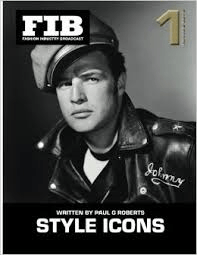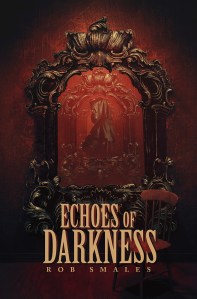By Stacey Longo

Style Icons, Volume I: Golden Boys (2014, Createspace Independent Publishing Platform) is the first in a series of coffee table books from Fashion Industry Broadcast, written by Paul G. Roberts. In this volume, the series examines the sex appeal of some major Hollywood actors of the 20th century.
The selection of actors offered is diverse and clearly carefully chosen. From the brooding handsomeness of Brando to the swashbuckling sexiness of Flynn, the book showcases a variety of talented, beautiful actors. It examines why these men were so appealing: on page 10, the author says, “It would be convenient to compare the greatest sex symbols to Greek gods … but a keener truth seems to be that we fancy our love gods deeply flawed.” I’d agree that this is true for most of the men in this book.
The book contains glossy photos, a biography on each actor, and links to videos (more on those later). The book opens with Marlon Brando, a personal favorite of mine. There’s a brief biography, and many smoldering photos to remind the reader of why he was so appealing. I particularly enjoyed a whimsical shot of Brando on the set of Apocalypse Now, where he looks relaxed and happy.
Next up is James Dean. The glossy photos capture his handsome face and bad-boy charm. Interesting note about the bio included here: I used to think Dean was bisexual. After reading this, now I think he was gay. This, of course, is irrelevant, because the main point is, he was a good actor and easy on the eyes.
Errol Flynn is featured next, and the pictures here emphasize his debonair reputation. Many actors today still emulate Flynn—indeed, in one photo, he reminded me of Cary Elwes; in another, Kevin Kline.
The chapter on Clark Gable was what I’d expected—several shots from Gone with the Wind, certainly his most famous role, along with candids of him with Carole Lombard and Marilyn Monroe.
The Cary Grant chapter was much like the others—a brief bio and several photos. The treasure in this chapter was a shot of him with Marilyn Monroe. She is posing, and he has a bewildered look on his face. It was a nice glimpse of Cary Grant, the man, not just Cary Grant, the actor.
I especially enjoyed the chapter on Rock Hudson. The photos emphasized how attractive he was, and the bio emphasized the tremendous impact he had on bringing AIDS to the spotlight. As I still remember the shock of seeing his gaunt face on the cover of People back in 1985, it was good to see him young and sexy again.
The Steve McQueen chapter offered no surprises, and served as a reminder of how cool he really was. He was followed by Paul Newman. It’s impossible not to love Paul Newman: besides being a genuinely nice guy—those eyes!
The chapter on Elvis Presley was sad. Though many of these icons died young, it’s tragic to look back on Elvis’s life, see how much he had going for him, and knowing that his life ended so soon. Yes, he was handsome, and the photos will remind you of that, but he was unhappy, too.
Finally, we have Rudolph Valentino to close out the book. His sex appeal was legendary, though photographs don’t always capture that essence of sexuality about him. Luckily, there are links that the reader can visit to see the man in action.
I did have some small issues with the book—it definitely needs another text edit, and it ends abruptly and without photo credits. (In all fairness, I have a review copy, so it’s possible that further edits were made after this version.) The video links throughout the volume will certainly enhance the e-book version of Style Icons, Volume I: Golden Boys, but in the print version, the location of the “play” icon in the center of each image was frustrating. However, this extra element of video links embedded throughout the book did make me want to purchase the e-book version.
Overall, Style Icons, Volume I: Golden Boys was an enjoyable read, and a respectful and intriguing look back at some of the screen’s most alluring leading men. You can buy it on Amazon by clicking here.








